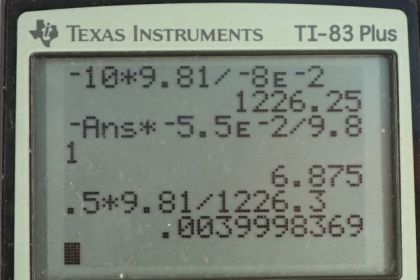Solution video
OpenStax College Physics, Chapter 16, Problem 1 (Problems & Exercises)
Calculator Screenshots
Comments
You have the answer for part (b) as the answer for part (a).
And you don't list part c in the answer set....
Is it possible to do this problem using the same formula, but taking the magnitude of (F) and (X) and dropping the negative before the (K)?
Yes, the calculation would work out to the same positive result. You can do this, and in Newton's Second Law questions (not Hook's Law questions like this) I usually take the magnitude of the forces and put negative signs in the equation, which is similar to the technique you're proposing of using magnitudes for displacement ( in this equation) and changing the equation to suite (by removing the negative in front of the ). For my own way of thinking I would find your proposal confusing since I like the negative in the equation to remind me that the direction of the spring force is opposite to the direction of the displacement of the end of the spring, but if you find a technique that reliably gives you the correct answer and you can explain why it works then go ahead with it.
All the best,
Shaun
where did the .5 come from in part (c)
Why are we using "g" as 9.81 now when we have been using it as 9.80?
Hi jsotosky, thank you for the question. Sorry for the inconsistency. The textbook often writes 9.80, but 9.81 is more often found elsewhere, such as wikipedia. It actually depends where on Earth you're located. is slightly greater at the poles, which are closer to the center of the Earth, whereas is less on the equator where the central bulge of the Earth makes you further from the center.
All the best,
Shaun


